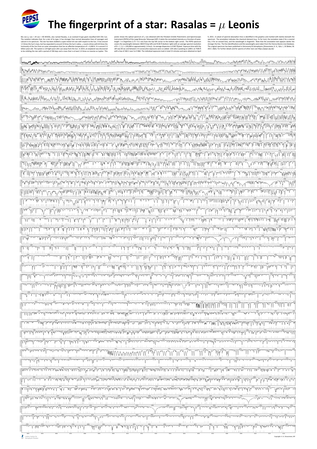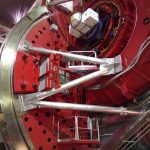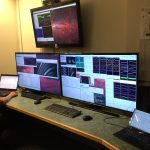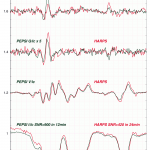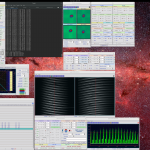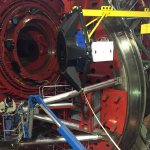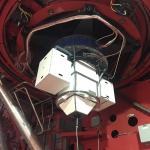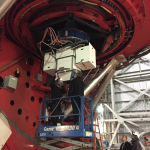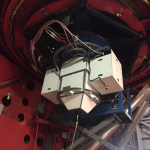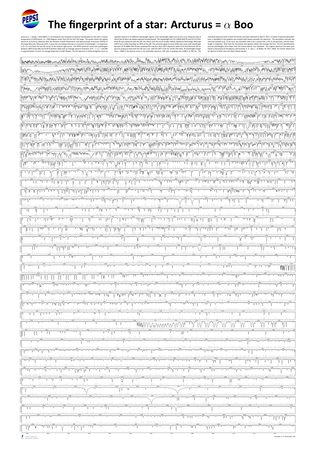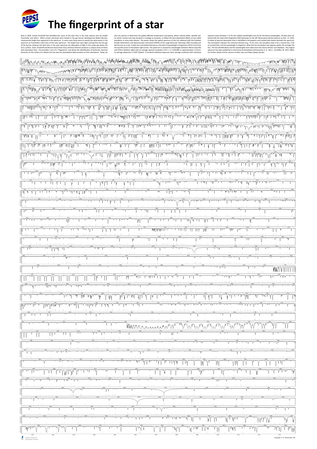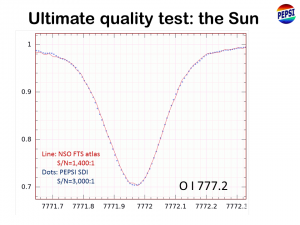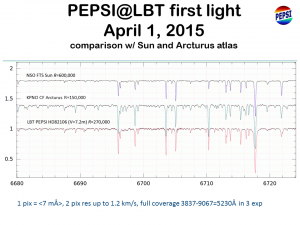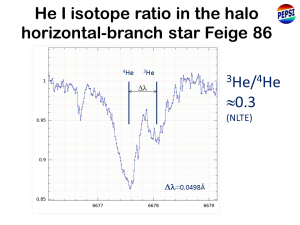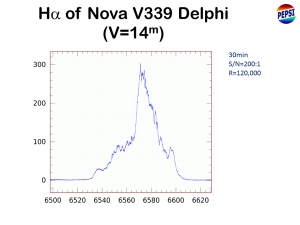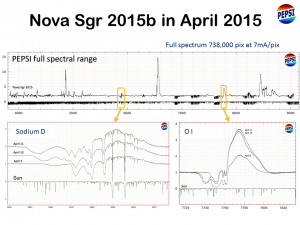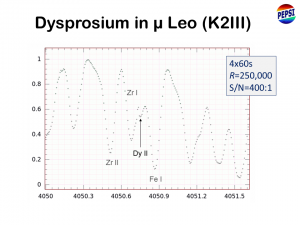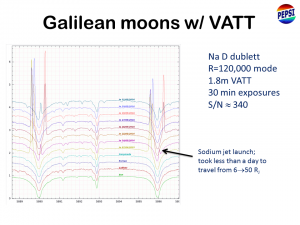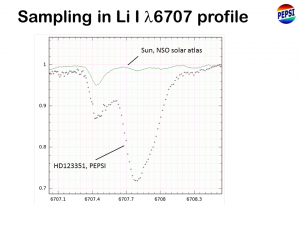The spectra presented in Paper I, II and III are available for download as A0 PEPSI posters. See the Wallposters section among the Library links.
Category Archives: First light
Spectrum poster of Sirius
The poster shows the optical spectrum of Sirius obtained with the Potsdam Echelle Polarimetric and Spectroscopic Instrument (PEPSI) of the Large Binocular Telescope (LBT).
Spectrum poster of Mu Leonis
The poster shows the optical spectrum of Mu Leonis obtained with the Potsdam Echelle Polarimetric and Spectroscopic Instrument (PEPSI) of the Large Binocular Telescope (LBT).
Posters presented at the 2nd LBT users meeting in Florence on June 20-23, 2017.
- K. G. Strassmeier, I. Ilyin, M. Weber, A. Järvinen, S. Järvinen, A. Mott, M. Steffen, C. Mack III, D., Sablowski, A. Liermann, M., Mallonn, T. Carroll, & J. Storm
First spectra with the Potsdam Echelle Polarimetric and Spectroscopic Instrument - K. G. Strassmeier, I. Ilyin, M. Steffen, E. Dineva, C. Denker
A spectrum of the Sun - K. G. Strassmeier, I. Ilyin, M. Weber
PEPSI deep spectrum library - K. G. Strassmeier, P. Gabor, I. Ilyin, C. Corbally, A. Järvinen, S. Järvinen, D. Sablowski, T. A. Carroll, M. Weber
The VATT-PEPSI connection - C. Mack III, K. G. Strassmeier, I. Ilyin, S. Schuler, F. Spada
A chemical analysis of the ancient planet-host star Kepler-444 - I. Ilyin
PEPSI data reduction - I. Ilyin, A. Järvinen, K. G. Strassmeier, M. Weber, M. Woche, F. Dionies
Preparing for PEPSI polarimetry - S. P. Järvinen, T. A. Carroll, D. P. Sablowski, K. G. Strassmeier, I. Ilyin
First Doppler images with PEPSI - M. Mallonn, E. Keles, K. G. Strassmeier
Exoplanet spectroscopy with LBC, MODS and PEPSI: Silicate aerosols in the atmosphere of the hot Jupiter HAT-P-32b - J. Tayar (OSU), et al.
Tests of Convective Zone Radial Differential Rotation in Intermediate Mass Core Helium Burning Stars with PEPSI
Polarimeters saw first light, LBT gets polarized
The installation of PEPSI at the LBT was completed on September 6th when both its polarimeters were mounted in the straight foci of the LBT. During the night of September 10, 2017 the telescope was pointed to the magnetic standard star gamma Equ and a series of integrations in circularly and linearly polarized light were obtained. These spectra have a spectral resolution of R=120,000, covered four wavelength regions in the optical (two always simultaneously) and reached a S/N ratio of up to 600:1 in 6 min integrations. The telescope was just tracking and not guiding yet nor were the wavefront sensors actively collimating the telescopes. The image quality was controlled by eye (by John Hill remotly from Tucson). Because the polarimeters for each of the LBT telescopes are identical and modular in design, circular and linear polarization may be obtained simultaneously. We used the SX side for circular and the DX side for linear polarization. A total of 12 exposures were obtained.
Image gallery
Spectrum poster of Epsilon Eridani
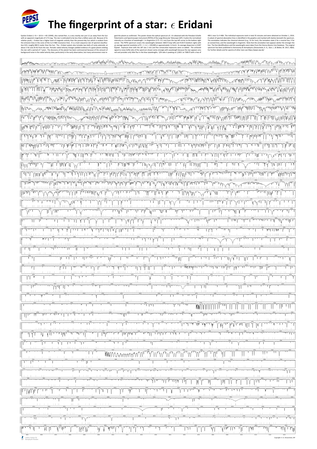 The poster shows the optical spectrum of Epsilon Eridani obtained with the Potsdam Echelle Polarimetric and Spectroscopic Instrument (PEPSI) of the Large Binocular Telescope (LBT).
The poster shows the optical spectrum of Epsilon Eridani obtained with the Potsdam Echelle Polarimetric and Spectroscopic Instrument (PEPSI) of the Large Binocular Telescope (LBT).
Spectrum poster of Arcturus
The poster shows the optical spectrum of Arcturus obtained with the Potsdam Echelle Polarimetric and Spectroscopic Instrument (PEPSI) of the Large Binocular Telescope (LBT).
Spectrum poster of the Sun obtained with SDI
The poster shows the optical spectrum of the Sun obtained with the Potsdam Echelle Polarimetric and Spectroscopic Instrument (PEPSI) of the Large Binocular Telescope (LBT) recorded just like the Sun-as-a-star.
Spectrum gallery from commissioning
CoRoT photometry and STELLA spectroscopy of an eccentric, eclipsing, and spotted HgMn binary with sub-synchronized rotation
Context. We report the discovery and analysis of very narrow transits in the eccentric spectroscopic binary HSS 348 (IC 4756).
Aims: The aim is to characterize the full HSS 348 system.
Methods: We obtained high-precision CoRoT photometry over two long runs and multi-epoch high-resolution échelle spectroscopy and imaging with STELLA and first PEPSI spectra.
Results: HSS 348 is found to be an eccentric (e = 0.18) double-lined spectroscopic binary with a period of 12.47 d in which at least the primary component is a peculiar B star of the HgMn class. The orbital elements are such that the system undergoes a grazing eclipse with the primary in front but no secondary eclipse. The out-of-eclipse light variations show four nearly equidistant but unequal minima stable in shape and amplitude throughout our observations. Their individual photometric periods are all harmonics of the same fundamental period which happens to agree with the transit period to within the errors. We interpret the fundamental period to be the rotation period of at least one if not both stars due to surface inhomogeneities. Due to the non-zero eccentricity of the orbit the two components are rotating sub-synchronously.
Conclusions: It appears that HSS 348 is not a member of the IC 4756 cluster but a background B8+B8.5 binary system. Its sharp eclipses every 12.47 days just mimic a small-body transit but are in reality the grazing eclipses of a B-star binary and thus a classical false positive. The system seems to be pre-main sequence with the primary possibly just arrived on the ZAMS. The light curve with four unequal minima can be explained with four cool spots of different size equidistantly positioned in longitude. Our data do not allow to uniquely assign the spots to either of the two stars.

Read more: Strassmeier et al. 2017, A&A 597, A55


